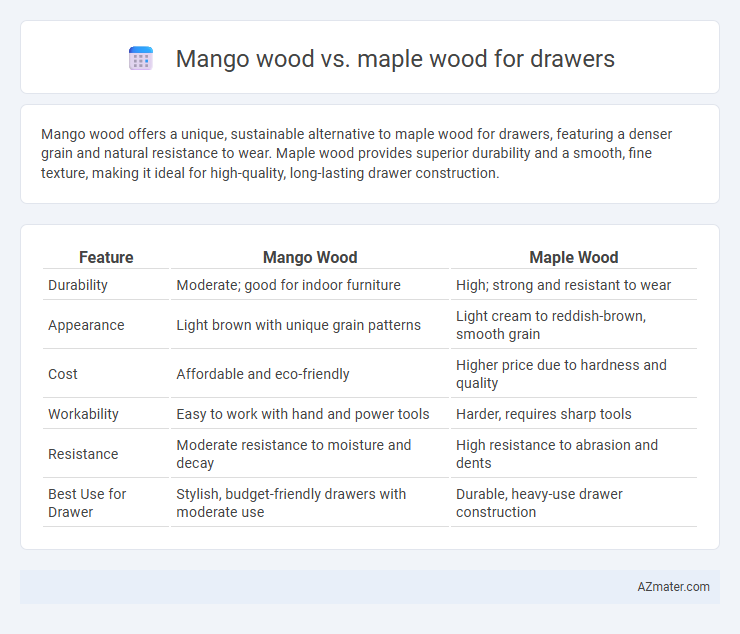Mango wood offers a unique, sustainable alternative to maple wood for drawers, featuring a denser grain and natural resistance to wear. Maple wood provides superior durability and a smooth, fine texture, making it ideal for high-quality, long-lasting drawer construction.
Table of Comparison
| Feature | Mango Wood | Maple Wood |
|---|---|---|
| Durability | Moderate; good for indoor furniture | High; strong and resistant to wear |
| Appearance | Light brown with unique grain patterns | Light cream to reddish-brown, smooth grain |
| Cost | Affordable and eco-friendly | Higher price due to hardness and quality |
| Workability | Easy to work with hand and power tools | Harder, requires sharp tools |
| Resistance | Moderate resistance to moisture and decay | High resistance to abrasion and dents |
| Best Use for Drawer | Stylish, budget-friendly drawers with moderate use | Durable, heavy-use drawer construction |
Introduction to Mango Wood and Maple Wood
Mango wood is a sustainable hardwood known for its strength, durability, and unique grain patterns, making it a popular choice for furniture like drawers. Maple wood, a dense and hard wood, is prized for its smooth finish, resistance to scratches, and light color, often used in cabinetry and drawer construction. Both woods offer distinct aesthetic and functional qualities ideal for durable and stylish drawer design.
Key Characteristics of Mango Wood
Mango wood features a dense, durable structure with a fine, smooth grain that resists warping, making it ideal for drawer construction. Its natural resistance to moisture and insect damage enhances longevity, while the rich, warm golden-brown hues and unique grain patterns add aesthetic value. Compared to Maple wood, Mango wood is more sustainable due to its status as a reclaimed product from fruit-bearing trees nearing end of life.
Key Characteristics of Maple Wood
Maple wood is renowned for its fine, uniform grain and exceptional hardness, making it highly durable for drawer construction. Its resistance to abrasion and wear ensures long-lasting performance, while the light, creamy color provides a versatile aesthetic that can be easily stained or finished. Maple's density and stability prevent warping and swelling, which is crucial for maintaining drawer alignment and smooth operation.
Durability: Mango Wood vs Maple Wood Drawers
Mango wood offers moderate durability with natural resistance to wear and insect damage, making it suitable for drawer construction in everyday use. Maple wood provides superior hardness and strength, significantly enhancing drawer longevity and resistance to dents and scratches. Choosing maple wood over mango wood usually results in more durable and long-lasting drawers, ideal for heavy-use environments.
Appearance and Grain Comparison
Mango wood features a rich, warm color palette with golden to reddish-brown hues and a distinctive swirling grain pattern that adds character to drawers. Maple wood exhibits a lighter, creamy white to pale reddish tone with a fine, uniform grain, providing a sleek and smooth finish for cabinetry. For drawer aesthetics, mango offers rustic charm and unique visual texture, while maple delivers a clean, classic appearance with consistent grain lines.
Workability and Ease of Crafting Drawers
Mango wood offers moderate workability due to its interlocked grain, requiring sharp tools for smooth cuts, making it suitable for drawer crafting with some care. Maple wood provides excellent ease of crafting drawers because of its fine, uniform grain and hardness, allowing for precise shaping and durable drawer components. Both woods are durable, but maple's consistent texture makes it preferred for intricate drawer joinery and smooth drawer movement.
Sustainability and Environmental Impact
Mango wood is a sustainable choice for drawers, sourced from fast-growing trees that are primarily harvested after fruit production declines, minimizing deforestation. Maple wood, while durable and dense, often comes from slower-growing hardwood forests that may contribute to greater environmental impact due to longer growth periods and less frequent harvesting. Choosing mango wood supports environmentally responsible woodworking through efficient resource use and lower carbon footprint compared to traditional maple wood.
Cost Difference: Mango vs Maple for Drawers
Mango wood tends to be more cost-effective than maple wood for drawer construction, offering a balance of durability and affordability. Maple wood, known for its hardness and fine grain, usually commands a higher price due to its superior strength and aesthetic appeal. Choosing mango wood can lower material expenses while still providing a sturdy and attractive drawer option.
Maintenance and Lifespan
Mango wood offers moderate durability with natural resistance to moisture, requiring regular oiling and gentle cleaning to maintain its appearance and prevent cracking. Maple wood is harder and more resilient, making it less prone to dents and scratches, and typically needs less frequent maintenance, such as occasional polishing to retain its smooth finish. Both woods have a long lifespan when properly cared for, but maple's density generally provides superior longevity for drawer construction.
Best Wood Choice for Drawers: Mango or Maple?
Maple wood offers exceptional strength and durability, making it an ideal choice for drawers that require long-lasting performance and resistance to wear. Mango wood, while also strong and eco-friendly, tends to have a more unique grain pattern and natural color variations, adding aesthetic appeal but slightly less hardness compared to maple. For drawer construction prioritizing durability and smooth gliding, maple wood is generally considered the best option, whereas mango wood is favored for its distinctive look and sustainability.

Infographic: Mango wood vs Maple wood for Drawer
 azmater.com
azmater.com